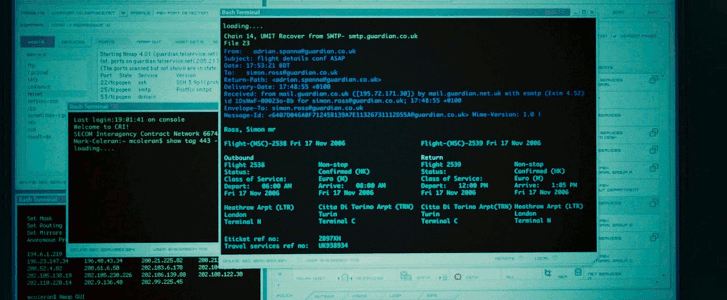
In addition to my list you can also check out this Comprehensive Guide to Nmap here and of course the man pages
Here are some really cool scanning techniques using Nmap
1) Get info about remote host ports and OS detection
nmap -sS -P0 -sV -O <target>
Change the -p argument for the port number. See “man nmap” for different ways to specify address ranges.
There are several other options. This one is plain and simple.
Another option is:
nmap -sP 192.168.0.0/24
for specific subnets
nmap accepts a wide variety of addressing notation, multiple targets/ranges, etc.
replace 192.168.0.1-256 with the IP’s you want to check.
I’ve used this scan to successfully find many rogue APs on a very, very large network.
Scan for open ports on the target device/computer (192.168.0.10) while setting up a decoy address (192.168.0.2). This will show the decoy ip address instead of your ip in targets security logs. Decoy address needs to be alive. Check the targets security log at /var/log/secure to make sure it worked.
Where < target > may be a single IP, a hostname or a subnet
-sS TCP SYN scanning (also known as half-open, or stealth scanning)
-P0 option allows you to switch off ICMP pings.
-sV option enables version detection
-O flag attempt to identify the remote operating system
Other option:
-A option enables both OS fingerprinting and version detection
-v use -v twice for more verbosity.
-sS TCP SYN scanning (also known as half-open, or stealth scanning)
-P0 option allows you to switch off ICMP pings.
-sV option enables version detection
-O flag attempt to identify the remote operating system
Other option:
-A option enables both OS fingerprinting and version detection
-v use -v twice for more verbosity.
nmap -sS -P0 -A -v < target >2) Get list of servers with a specific port open
nmap -sT -p 80 -oG – 192.168.1.* | grep openChange the -p argument for the port number. See “man nmap” for different ways to specify address ranges.
3) Find all active IP addresses in a network
nmap -sP 192.168.0.*There are several other options. This one is plain and simple.
Another option is:
nmap -sP 192.168.0.0/24
for specific subnets
4) Ping a range of IP addresses
nmap -sP 192.168.1.100-254nmap accepts a wide variety of addressing notation, multiple targets/ranges, etc.
5) Find unused IPs on a given subnet
nmap -T4 -sP 192.168.2.0/24 && egrep “00:00:00:00:00:00″ /proc/net/arp6) Scan for the Conficker virus on your LAN ect.
nmap -PN -T4 -p139,445 -n -v –script=smb-check-vulns –script-args safe=1 192.168.0.1-254replace 192.168.0.1-256 with the IP’s you want to check.
7) Scan Network for Rogue APs.
nmap -A -p1-85,113,443,8080-8100 -T4 –min-hostgroup 50 –max-rtt-timeout 2000 –initial-rtt-timeout 300 –max-retries 3 –host-timeout 20m –max-scan-delay 1000 -oA wapscan 10.0.0.0/8I’ve used this scan to successfully find many rogue APs on a very, very large network.
8) Use a decoy while scanning ports to avoid getting caught by the sys admin
sudo nmap -sS 192.168.0.10 -D 192.168.0.2Scan for open ports on the target device/computer (192.168.0.10) while setting up a decoy address (192.168.0.2). This will show the decoy ip address instead of your ip in targets security logs. Decoy address needs to be alive. Check the targets security log at /var/log/secure to make sure it worked.
9) List of reverse DNS records for a subnet
nmap -R -sL 209.85.229.99/27 | awk ‘{if($3==”not”)print”(“$2″) no PTR”;else print$3″ is “$2}’ | grep ‘(‘This command uses nmap to perform reverse DNS lookups on a subnet. It produces a list of IP addresses with the corresponding PTR record for a given subnet. You can enter the subnet in CDIR notation (i.e. /24 for a Class C)). You could add “–dns-servers x.x.x.x” after the “-sL” if you need the lookups to be performed on a specific DNS server. On some installations nmap needs sudo I believe. Also I hope awk is standard on most distros.
Hope you have fun, and remember don’t practice these techniques on machines or networks that are not yours.
Source
10) How Many Linux And Windows Devices Are On Your Network?
sudo nmap -F -O 192.168.0.1-255 | grep “Running: ” > /tmp/os; echo “$(cat /tmp/os | grep Linux | wc -l) Linux device(s)”; echo “$(cat /tmp/os | grep Windows | wc -l) Window(s) devices”Hope you have fun, and remember don’t practice these techniques on machines or networks that are not yours.
Source
No comments:
Post a Comment